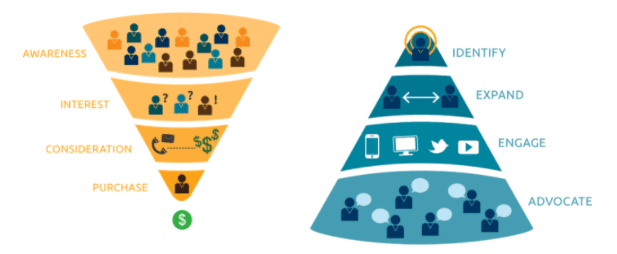There’s been a lot of buzz of lately about account-based marketing (ABM) as a possible next wave in marketing best practices, following the inbound marketing framework that has dominated B2B digital marketing for the past decade. The issue was highlighted when inbound marketing juggernaut HubSpot made a sizable investment in account-based marketing platform maker Terminus in May 2017.
Inbound vs. ABM
The easiest way to understand the difference between inbound marketing and ABM is by looking at the sales funnel of each framework. With inbound marketing, you design your website to attract traffic, convert traffic to leads, and leads into closed business using SEO, calls to action, and email marketing. It’s all about getting your ideal customers to come to you–you start with a large target audience at the top of the funnel, and as leads work their way down the funnel, the funnel narrows and an ideal customer drops out of the bottom.

ABM flips the inbound marketing funnel upside down. You start by identifying a target customer in the form of a business (account) that you know is a good fit for your company. More specifically, you identify the individual or department within the account that is the business decision maker. In addition to creating highly targeted content aimed at decision makers, you widen the funnel to include influencers and other stakeholders with content targeted to get their attention and form a favorable opinion of your product. In some ABM frameworks, digital advertising is used to target specific companies, and specific roles within those companies, with ads linked to landing pages that deliver content offers in exchange for the contact information of your target audiences. Others integrate with business directories like Dunn and Bradstreet to identify businesses and decision makers. Some offer a combination of both of these methods.
Company Personas vs. Buyer Personas
Inbound marketing starts with buyer personas–fictionalized representations of your ideal customers. Everything you do is then shaped around that typical person, to help people confirm their problems, identify solutions, and to guide them to your solution as the right one for that individual or business.
ABM starts with company personas–identifying companies that are an ideal fit for your product or service. Buyer personas are still relevant in the sense that you will identify individuals within a company to contact, but instead of working with fictionalized profiles, you’ll be looking at specific individuals or groups within a specific company.
A typical buyer persona will include answers to these kinds of questions:.
- What is the buyer’s job role and title?
- How is his or her job measured?
- What does a typical day look like?
- What skills are required to do the job?
- What knowledge and tools does he or she use for their job?
- Who do they report to? Who reports to them?
- What are the buyer’s goals?
- What are they accountable for?
- What does it mean to be successful?
- What are their biggest challenges?
A company persona, on the other hands, asks questions like:
- What industry is the company in?
- How many employees does the company have?
- What department makes decisions about your product?
- What is the company’s annual revenue?
- What kind of budget does your target department have?
- Is it in the right geography for your business?
- What technology does the company rely on?
- What is the size of its customer base?
- What is the level of organizational or technological maturity around your product?
Why ABM?
Why is ABM seen by some as a successor to inbound marketing for many businesses? Because inbound marketing has been a victim of its own success, especially in businesses where products and services are commoditized. The competition for SEO rankings and pay-per-click advertising is such that in many industries, the largest brands make it nearly impossible for smaller or newer companies to get found by people searching online for what they offer. They lack the SEO clout and the advertising budget to rank.
ABM also recognizes that, especially in B2B purchases, multiple people and departments are often involved in technology adoption, and pushing content to people is more efficient than hoping the right combination of people will come to your website.
ABM Benefits
The primary benefit of ABM, according to its advocates, is sales acceleration. Targeting specific accounts gets you farther, faster, than with traditional inbound marketing. Of course, that depends somewhat on the buying cycle of what you are selling. The larger the purchase, and the more complicated the purchase process is, the more ABM is likely to accelerate sales. Other benefits that ABM supporters point to are better sales and marketing alignment–you have to collaborate on target accounts–and the ability to close bigger deals by identifying the accounts in advance. The end result is a smoother and faster funnel flow which benefits both sellers and customers.
Best of Both Worlds
It’s also possible for inbound and ABM to work together. After all, some of the basic tactics of inbound marketing like compelling content, landing pages, calls to action, and workflows will still be needed whether attracting web searchers or targeting individuals. Also, in highly specialized industries with high-niche products, search marketing is not as congested and it is easier to get found by your target audience.
